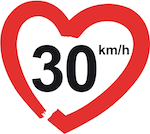Decree of 29.11.1990: Local authorities may implement measures for traffic calming in their quarters.
The city of Fontenay aux Roses announced to become a “Ville à 30” in 2005. This became the name of
a network “Ville à 30” (active in France, Belgium and Switzerland)
| Angers | 50.000 residents | “Ville à 30” sinve 2012, first French big city with majority of roads with 30 km/h, additionally wide pedestrian zones |
| Aytré | 9.000 residents | “Ville à 30” since 2010, whole city centre with 30 km/h |
| Bougival | 8.000 residents | “Ville à 30” since 2011 |
| Chambéry | 58.000 residents | 30% of all roads with 30 km/h |
| Clamart | 52.000 residents | “Ville à 30” since 2010, first measures for traffic calming in end of 2002/beginning 2003; decision to implement 30 km/h on all local roads in 2008 (except arterial roads) |
| Fontainebleau | 14.900 residents | “Ville à 30”, 30 km/h in the whole city, except arterial roads. since 2010 |
| Fontenay-aux-Roses | 23.000 residents | “Ville à 30” since 2005 (Initiator), whole city centre with 30 km/h |
| La Roche Blanche | 1.100 residents | 75% of the local road network with 30 km/h (ca 4 km), decision to further extend 30 km/h |
| Lorient | 60.000 residents | “Ville à 30” since 2007, 90% of the road network with 30 km/h since 2009 (Certu) |
| Lyon | 496.300 residents | 30 km/h zone since 1999 |
| Melun | 5.000 residents | 30 km/h in the whole municipality, except arterial roads, since October 2013 |
| Metz | 119.600 residents | official goal to reduce speed in the whole municipality: 30 km/h in the city centre and around schools and shopping centres etc; first pedestrian zones in 1973, first 30 km/h zone since 1991; Mix with 30 km/h zones, pedestrian zones and shared-space zone today |
| Millau | 22.000 residents | about 40% of the roads with 30 km/h, one additional 20 km/h zone |
| Mouants-Sartoux | 10.400 residents | local roads with 30 km/h (decidec 2013), also shared-space zone |
| Nantes | 291.600 residents | City has developed strategical planning for traffic calming und for a city of short ways |
| Nogent-sur-Marne | 30.000 residents | “Ville à 30” since 2006, whole city (centre?) with 30 km/h |
| Paris | 2.240.600 residents | expansion of 30 km/h zones from 70 to 100 since summer 2013; additionally implementation of 30 km/h on several grand avenues; city developped programm “share the streets” (including 560 km equalling one third of the whole road network; new plannings published in April 2015 include a budget of 30 million Euro in order to implement new concepts with 30 km/h |
| Ploeren | 6.000 residents | Tempo 30 in der ganzen (Innen?)-Stadt, Plan 2003 verabschiedet |
| Rennes | 213.000 residents | 36% of the road network are currently 30 km/h zones. Plannings to implement 75% with 30 km/h by 2020. |
| Sceaux | 20.000 residents | first 30 km/h zone in 1995; “Ville à 30” since 2007 when several 30 km/h zones were implemented; expansion (to the whole city?) since that time, implementation is very popular among residents |
| Straßburg | 274.400 residents | Wide parts of the city centre were converted into Ł bikefriendly and traffic-calmed area, with numerous 30 km/h areas. Plannings to implement 30 km/h in the whole city could not be realised due to a local referendum opposing. Further implementation projects are therefore being introduced on a step by step basis. |
| Villecresnes | 10.000 residents | “Ville à 30” since 2009, whole city (centre?) withe 30 km/h |


